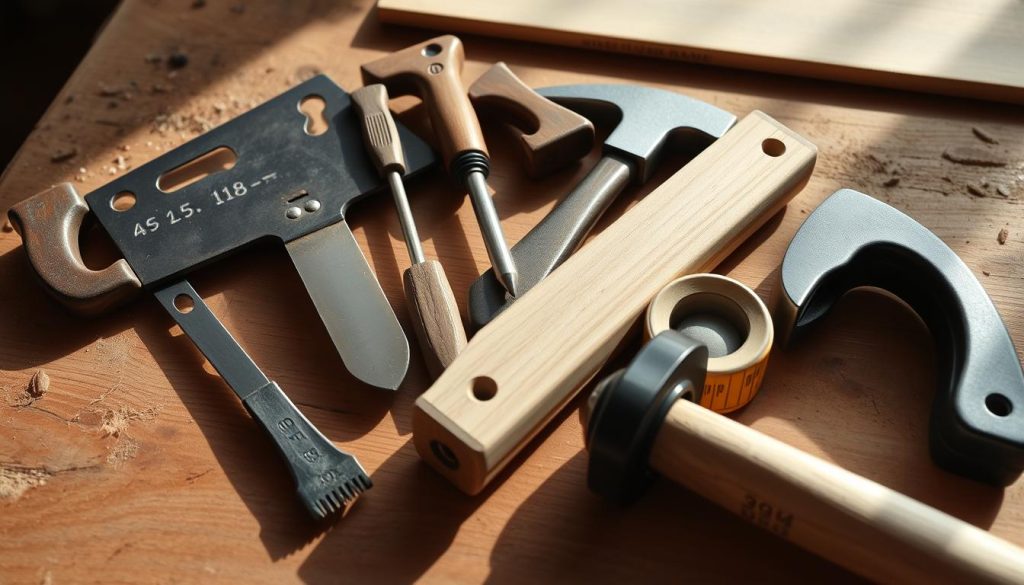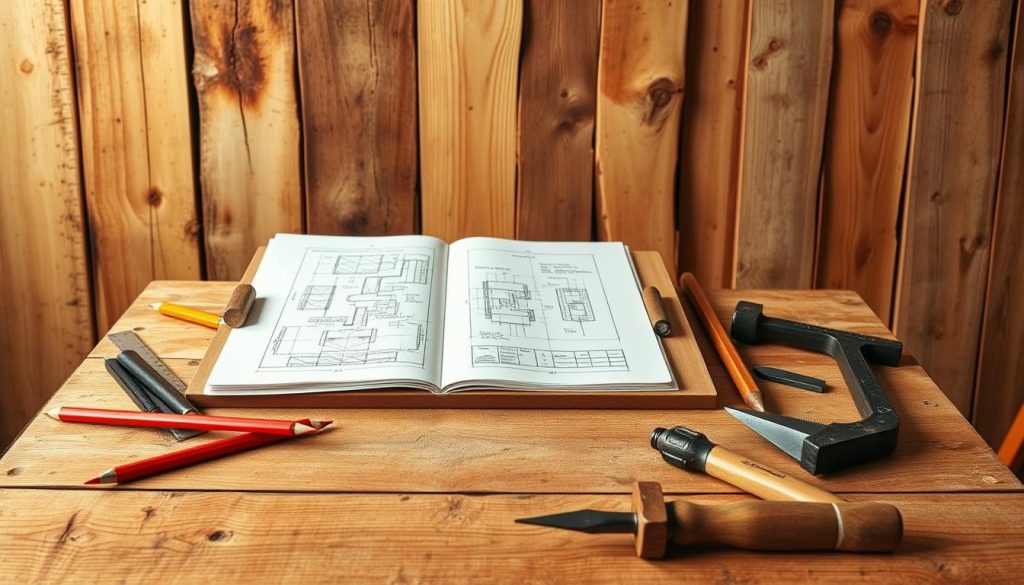Diving into beginner wood projects opens a world of creativity and skill-building. It’s perfect for those who want to make useful home items or try a new hobby. Woodworking is an exciting journey for DIY fans of all levels.
Easy woodworking projects are a great way to start if you’re new to woodwork. You can make simple serving trays or custom shoe storage. These DIY wood ideas can change your home and boost your confidence in making unique items.
Woodworking is more than making things; it’s about learning patience, precision, and solving problems. Beginners find joy in turning raw materials into beautiful, useful pieces. These pieces show off their creativity and skill.
Key Takeaways
- Woodworking is an accessible hobby for beginners of all ages
- DIY wood projects can be both functional and decorative
- Start with simple projects to build confidence and skills
- Woodworking offers a creative outlet for personal expression
- Basic tools and materials are affordable for most beginners
Why Woodworking is Great for Beginners
Woodworking is an exciting journey for beginners. It’s a creative craft that anyone can enjoy. It offers many benefits for people of all ages and skill levels.
Whether you’re new to hobbies or want to learn practical skills, woodworking is perfect. It opens up a world of possibilities.
Benefits of Woodworking for All Ages
Woodworking has many advantages. It improves critical thinking and hand-eye coordination. It also gives a sense of accomplishment.
People of all ages can enjoy creating something with their hands. It’s a hobby that brings joy to everyone.
- Stress reduction through creative expression
- Improved problem-solving skills
- Physical exercise and mental stimulation
- Cost-effective hobby with practical results
Essential Skills You’ll Learn
Woodworking teaches beginners valuable skills. You’ll learn to measure, cut, sand, and assemble wooden projects. These skills are the foundation for more advanced techniques.
- Precise measurement techniques
- Safe tool handling
- Understanding wood grain and properties
- Basic design and planning
Projects to Boost Your Confidence
Starting with simple projects boosts confidence. Beginners can make useful items like small shelves or picture frames. Each project you finish gives you a sense of achievement.
This motivates you to try more challenging projects. It’s a great way to grow in woodworking.
Essential Tools for Beginner Wood Projects
Starting your woodworking journey needs the right tools. Whether you’re into beginner woodworking projects or improving your skills, knowing the essential tools is key. This guide will help you start strong on your woodworking path.

Must-Have Hand Tools
Every beginner woodworker needs a solid set of hand tools. These basic tools will help you measure, cut, and shape wood accurately.
- Measuring tape: Accurate measurements are critical for woodworking projects
- Carpenter’s square: Ensures perfect 90-degree angles
- Chisels: Essential for carving and detailed work
- Hand saw: Perfect for basic cutting tasks
- Hammer: Versatile tool for multiple woodworking techniques
Essential Power Tools
Power tools can greatly improve your efficiency and precision in woodworking. Start with these key items:
- Cordless drill: Versatile and portable for various tasks
- Circular saw: Ideal for straight cuts and larger wood pieces
- Random orbital sander: Helps create smooth, professional finishes
- Jigsaw: Great for curved and intricate cuts
Safety Gear You Should Use
Beginner woodworking tips always stress safety. Protect yourself with these essential safety items:
- Safety glasses: Protect your eyes from wood chips and dust
- Ear protection: Reduce noise from power tools
- Dust mask: Prevent inhalation of wood particles
- Work gloves: Protect hands from splinters and cuts
Investing in quality tools and safety gear is crucial for success in woodworking. Good tools make learning and creating more fun.
Simple Wood Projects to Get Started
Starting with easy woodworking projects is exciting for beginners. These projects help you learn, grow, and make something special. They’re great for those new to woodworking, letting you explore and learn the basics.
Begin with small projects to learn the basics and feel accomplished. Here are some fun wood projects for beginners.
Wooden Coasters: A Quick Project
Wooden coasters are a great first project. They teach you to measure, cut, and finish wood. You’ll learn:
- Selecting the right wood
- Making accurate cuts
- Sanding surfaces
- Applying finishes
Picture Frames: Personalize Your Space
Building custom picture frames is a fun challenge. It teaches you about joining and measuring. You’ll do:
- Picking materials
- Cutting wood at exact angles
- Assembling the frame
- Adding your own style
Birdhouses: Fun for Kids and Adults
Birdhouse building is fun for everyone. It teaches you important skills and makes something useful. You’ll learn:
- Cutting various wood pieces
- Basic design
- Using different tools
- Making something for wildlife
These projects are stepping stones to bigger challenges. They help you grow and learn valuable skills.
Planning Your First Wood Project
Starting with beginner wood projects needs careful planning. Woodworking can seem tough at first, but you’ll get better fast. The key is to prepare well before you start working with tools.

Planning your first project involves important steps for success. Knowing these basics helps you make great pieces and avoid mistakes.
Selecting the Right Wood
Choosing the right wood is key for beginners. Different types of wood affect your project’s look and feel:
- Pine: Soft, affordable, great for practice
- Cedar: Lightweight, naturally weather-resistant
- Oak: Durable, strong, ideal for furniture
- Maple: Hard, smooth, perfect for detailed work
Understanding Woodworking Plans
Reading woodworking plans can be hard for beginners. Start by breaking plans into simple parts. Look for:
- Materials list
- Cutting dimensions
- Assembly instructions
- Recommended tools
Measuring and Marking Techniques
Accuracy is crucial in woodworking for beginners. Spend time learning to measure and mark well. Use sharp pencils, quality measuring tapes, and square tools for clean cuts. This will make your projects look better.
Wood Joinery Basics for Beginners
Learning wood joinery is key for those starting in woodworking. It helps you connect wood pieces well. This makes your DIY projects better and last longer.
Wood joinery turns simple tips into expert-level work. Beginners can feel more confident by learning basic joining methods. These methods make wood connections strong and smooth.
Popular Joining Methods
Each woodworking project needs a special joining technique. Here are some important ones to try:
- Butt Joints: Simplest connection method for right-angle connections
- Miter Joints: Perfect for creating clean, angled corners
- Dado Joints: Ideal for shelving and structural connections
- Lap Joints: Provide increased strength for parallel wood pieces
Using Wood Glue Effectively
Wood glue is crucial for beginners. Choose the right glue for your project and the environment.
- Apply glue evenly across joining surfaces
- Use clamps to maintain pressure during drying
- Allow sufficient drying time before handling
- Clean excess glue immediately with a damp cloth
Introduction to Fasteners
Fasteners add extra support to your projects. Nails, screws, and bolts each have their own role in joining wood.
- Nails: Quick temporary connections
- Screws: Strong, removable fastening
- Wood dowels: Invisible, sturdy connections
- Bolts: Heavy-duty structural joining
With these tips, you’ll get better at making wood projects that look professional. You’ll do it with confidence and precision.
Taking Care of Your Wood Projects
Making beautiful DIY wood ideas is just the start. You also need to take care of them to keep them looking great. Learning how to finish and protect your wood will make it last longer.
There are a few important steps to protect your woodworking projects. These steps can make your DIY wood ideas look like they were made by a pro.
Sanding Tips for a Smooth Finish
Getting a smooth surface is key for any wood project. Start with coarse-grit sandpaper and then move to finer grits for the best look:
- Begin with 80-grit sandpaper for rough surfaces
- Progress to 120-grit for initial smoothing
- Finish with 220-grit for a silky-smooth texture
Choosing the Right Finish
Each simple wood craft needs a different finish. Here are some options to protect your wood:
- Polyurethane for durability
- Danish oil for a natural look
- Wax for delicate surfaces
Maintaining Your Wooden Creations
Keeping your DIY wood ideas in top shape is easy. Just dust them with a soft cloth often. Also, avoid direct sunlight and extreme humidity. Reapply finish every few years to keep the wood beautiful.
Creative Ways to Personalize Your Wood Projects
Turning simple DIY wood ideas into unique masterpieces is easier than you think. Easy woodworking projects become extraordinary with personal touches. These touches show your creativity and style. Personalizing your wooden creations makes them one-of-a-kind, showcasing your artistic vision.
Woodworking enthusiasts can explore many techniques to make their projects stand out. Here are some exciting ways to add character to your wooden crafts:
Stenciling and Painting Techniques
- Select acrylic or chalk paint for best results
- Use painter’s tape to create clean design lines
- Practice stencil techniques on scrap wood first
- Experiment with color combinations and patterns
Adding Decorative Elements
Elevate your DIY wood ideas by adding unique decorative hardware, metal accents, or intricate wood inlays. Simple additions like vintage knobs, copper brackets, or carved details can dramatically transform an ordinary woodworking project into a stunning piece of functional art.
Tips for Unique Design Ideas
- Draw inspiration from nature and architectural styles
- Combine different wood types for visual interest
- Use wood burning techniques for personalized graphics
- Consider mixing traditional and modern design elements
Remember, easy woodworking projects become extraordinary with your personal creativity. Don’t be afraid to experiment and let your imagination guide your design process.
Joining a Woodworking Community
Woodworking for beginners can seem scary, but finding friends who love it makes it easier. Learning with others who get it makes your journey smoother.
Finding the right group can speed up your learning and offer great support. Woodworking groups have many ways to help you grow.
Local Workshops and Classes
- Community colleges often host woodworking classes
- Local hardware stores offer weekend workshops
- Craft centers provide hands-on learning experiences
- Adult education programs teach basic woodworking skills
Online Communities and Resources
- Reddit woodworking forums
- Facebook woodworking groups
- YouTube tutorial channels
- Specialized woodworking websites with discussion boards
Benefits of Networking with Other Woodworkers
Talking to seasoned woodworkers boosts your confidence and skills. You learn new techniques and avoid mistakes. Sharing ideas and getting feedback is a big plus.
Whether you like meeting people in person or online, joining woodworking groups makes your hobby more fun. It turns solo crafting into a team effort.
Advanced Beginner Projects to Challenge Yourself
As you get better at woodworking, it’s time to try more complex projects. These advanced projects will boost your confidence and teach you new skills. You’ll make useful and fun pieces.
Woodworking projects can get more challenging as you learn. Shelving units are a great way to use many skills. You’ll learn about measuring, joining wood, and making things look good.
Outdoor furniture is another great challenge. You can make benches, planters, and garden seats. These projects teach you about using weather-resistant wood and finishing techniques.
Wooden toys are a fun project for both kids and collectors. Making toys requires precision and creativity. You’ll make wooden cars and puzzles that are both fun and meaningful.